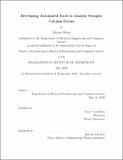Developing automated tools to analyze synaptic calcium events
Author(s)
Weiss, Alyssa(Alyssa F.)
Download1193031753-MIT.pdf (2.085Mb)
Other Contributors
Massachusetts Institute of Technology. Department of Electrical Engineering and Computer Science.
Advisor
Troy J. Littleton.
Terms of use
Metadata
Show full item recordAbstract
Synapses are the fundamental building blocks of the nervous system. Neuroscientists use electrophysiological approaches to measure synaptic release, which lack spatial resolution to measure synaptic transmission at the resolution of single synapses. One challenge in accurate measurements is the lack of reliable quantitative tools to detect synaptic signals from individual synapses. Moreover, the small size of synapses makes it tedious to measure synaptic transmission and analyze it manually. To overcome this problems, in this thesis, a range of tools to analyze calcium florescent images of synaptic regions were implemented and developed in order to create a pipeline for gathering synaptic release information from calcium imaging data. Using this analysis pipeline, we quantified synaptic signals, mapped the probability of release and applied machine learning tools to classify synapses as high and low probability synapses. The final result of this thesis aims to demonstrate that it is possible to create a set of tools that can automate the process of calculating synapse release information at a level that drastically improves upon the efficiency of manual work and that has, ideally, near human accuracy.
Description
Thesis: M. Eng., Massachusetts Institute of Technology, Department of Electrical Engineering and Computer Science, May, 2020 Cataloged from the official PDF of thesis. Includes bibliographical references (pages 55-56).
Date issued
2020Department
Massachusetts Institute of Technology. Department of Electrical Engineering and Computer SciencePublisher
Massachusetts Institute of Technology
Keywords
Electrical Engineering and Computer Science.